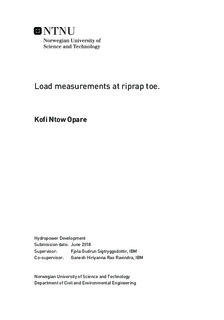| dc.contributor.advisor | Sigtryggsdottir, Fjola Gudrun | |
| dc.contributor.advisor | Ravindra, Ganesh Hiriyanna Rao | |
| dc.contributor.author | Opare, Kofi Ntow | |
| dc.date.accessioned | 2018-09-11T14:01:38Z | |
| dc.date.available | 2018-09-11T14:01:38Z | |
| dc.date.created | 2018-06-07 | |
| dc.date.issued | 2018 | |
| dc.identifier | ntnudaim:18881 | |
| dc.identifier.uri | http://hdl.handle.net/11250/2562106 | |
| dc.description.abstract | Riprap is widely used as slope protection and when placed on the downstream slope of a rockfill dam, it provides erosion resistance under overflow conditions. For steep downstream slopes (S > 50%), initiation of riprap failure at the dam toe can be considered a possibility under overtopping conditions of rockfill dams. The present study focuses on the load generation mechanisms that are present at the dam toe in the event of overtopping. Placed ripraps for the tests were constructed in an interlocking pattern on a model of a downstream slope of an embankment dam in the hydraulic laboratory at NTNU, Trondheim.
In order to quantify the loads acting at the dam toe during overtopping, load cells were installed at the toe to measure those loads. Monitoring of load generation at the toe showed two different types of loads acting the toe section of the dam. The first is the self-weight of the riprap stones during building of the riprap structure and the other is the hydraulic load as a result of overtopping of the dam. The effect of the latter at the toe is dependent on the discharge of the overflow with higher discharges resulting in higher hydraulic loads at the dam toe. The hydraulic load causes a two dimensional displacement of the riprap stones that causes the entire structure to buckle resembling that of a slender long column pinned at one end and free at the other end. This buckling eventually leads to riprap failure. Rearrangement of the riprap stones resulted in progressive displacement of the stones along the slope leading to compaction of the stones at the toe section due to the fact that the entire structure is supported at the base and further loosening of the stones in the upper section. This compaction leads to a change in the magnitude of the effect of the riprap self-weight felt at the toe of the dam even when overtopping ceases. | |
| dc.language | eng | |
| dc.publisher | NTNU | |
| dc.subject | Hydropower Development | |
| dc.title | Load measurements at riprap toe. | |
| dc.type | Master thesis | |

